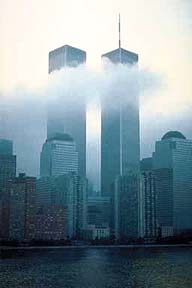
Thoughts on what happened September 11, 2001
That day terrorism on a scale previously unknown struck the governmental and financial capitols of the United States, and Americans of yet another era lost their innocence. In an elaborate and fiendishly well timed assault four airliners bound from the East to West coasts were hijacked and aimed toward prearranged targets. Cell phone calls were made from all the hijacked planes to officials and loved ones describing the events taking place on each plane.

The World Trade towers were for a time the tallest buildings in the world, standing 1,362 feet tall. A tall antenna on the North tower broke up the mirror image appearance. They towered over their immediate surroundings, while the venerable Empire State Building is surrounded by numerous tall neighboring structures.
At 8:45 A.M. Eastern time September 11, 2001 the North tower was struck by a passenger jet, an act captured by chance while taping a story involving firemen (left).
The second jet struck the South tower at 9:03, and was captured by dozens of cameras from many angles and distances (below). In retrospect the second crash seems intended to be widely witnessed. The images of that second jet burying itself into the side of the building and the destructive aftermath became the most documented and spectacular video event of all time.

The Pentagon was struck by another hijacked jet at 9:38 A.M., and the last plane involved, United Airlines flight 93, apparently was directed toward the Capitol. Flight 93 failed to reach its target due to an attempt by passengers, alerted to the plot by cell phone conversations with loved ones, to resist the hijackers. The last desperate moment were captured on in the cockpit voice recorder of that plane before it nosed down into a Pennsylvania field. Based on the scant evidence the terrifying story of the five minute fight for survival appears to resemble the following: Some of the flight attendants and more able passengers rounded up items which could make improvised weapons such as bottles, containers of hot coffee, and the metal food cart itself. As one yelled "Let's get them" they rushed the hijackers and both groups pummeled and slashed at each other. One hijacker broke away from his overwhelmed companions and ran towards the cockpit, as several passengers screamed 'Stop him!' More crashing and screams followed, then with the control of the cabin reclaimed they desperately tried to break down the cockpit door, one voice crying "If we don't get in there, we'll die!" The food cart was then used as a battering ram, as the murderous Saudis at the controls audibly prayed. They brought the plane to a perilously low altitude then violently rolled the plane to disrupt the assault. Bursting inside, the final battle began within the cramped cabin. The hijacker pilots steadily lost their ability to control the flight, perhaps bringing the nose down at the last moment as the closest passengers desperately tried to fight away the aircraft controls. There were screams of "roll it! pull it up!" then a rushing sound as control surfaces roared against the air, perhaps tearing free. The plane rolled upside down and at 10:03 plowed into a Pennsylvania field.
 As the twin
towers burned, practically everyone above the impacted floors
were doomed. Hundreds of phone conversations and messages left
on answering machines were the last words many relatives and loved
ones were to hear from people trapped in the towers. The floors
near the crashes were the scene of unimaginable fiery horror.
Only a few on the fringes of these floors survived, many badly
burned. All the stairways were destroyed in the first tower hit,
but the off center strike of the second plane left one partially
blocked stairway several people from the upper floors managed
to escape through. Dozens of people in the upper stories in the
first stricken tower jumped to their deaths rather than burn.
In the lower floors some waited for word on what to do, others
fled using still passable elevators and stairs. Thousands of people
migrated downwards, finally passing firefighters near the ground
floor who helped clear the bottlenecks gathering near the exits.
Some of the evacuees waited in the building lobby, and a loudspeaker
actually declared at one point that all was clear, telling people
to go back to their offices! Many who would have otherwise lived
then started back up the stairs. Thousands wisely decided to get
away from the towers to avoid falling glass and bodies, but the
coming horrific climax of the catastrophe was as yet largely unanticipated.
Firemen were just reaching the fiery floors, and were beginning
rescue and fire fighting operations.
As the twin
towers burned, practically everyone above the impacted floors
were doomed. Hundreds of phone conversations and messages left
on answering machines were the last words many relatives and loved
ones were to hear from people trapped in the towers. The floors
near the crashes were the scene of unimaginable fiery horror.
Only a few on the fringes of these floors survived, many badly
burned. All the stairways were destroyed in the first tower hit,
but the off center strike of the second plane left one partially
blocked stairway several people from the upper floors managed
to escape through. Dozens of people in the upper stories in the
first stricken tower jumped to their deaths rather than burn.
In the lower floors some waited for word on what to do, others
fled using still passable elevators and stairs. Thousands of people
migrated downwards, finally passing firefighters near the ground
floor who helped clear the bottlenecks gathering near the exits.
Some of the evacuees waited in the building lobby, and a loudspeaker
actually declared at one point that all was clear, telling people
to go back to their offices! Many who would have otherwise lived
then started back up the stairs. Thousands wisely decided to get
away from the towers to avoid falling glass and bodies, but the
coming horrific climax of the catastrophe was as yet largely unanticipated.
Firemen were just reaching the fiery floors, and were beginning
rescue and fire fighting operations.
Around 10 A.M. the South tower's structure gave way at it's fire weakened point. The disintegrating upper stories fell into an erupting widening flood of debris and gray dust. The air inside the lower portion of the building compressed and blew lower walls and whatever was within them down and outwards. Many spreading plumes arced down, forming radial streamers led by large disintegrating chunks of the building. The squeezed trapped air in the lower floors roared through the remaining structure not unlike what happens in a sinking ship. The dense column of smoke where the upper tower had been a moment before could be seen to be sucked downwards into the plunging rolling debris column as the tremendous volume dropped and spread beneath it.
The smoke seemingly hid the tower, and for many seconds one could not tell that the building was gone, then the smoke gave way in a stupefying unveiling of the empty space. The concrete in the building was largely pulverized into a fine powder on the way down, with broken stone, wood, and ground glass suspended in the roaring avalanche. Walls, offices, furniture, and bodies joined the chaotic mass. As it thundered to the ground the energy of the descending debris cloud was thrown outwards, sending turbulent gray masses writhing for great distances through the surrounding city, driving fleeing crowds before it. Many unlucky ones caught inside were knocked down, pummeled, scoured, and exposed to hazardous materials. Within 10 seconds several hundred people in and around the tower were killed. Papers once carefully sorted and protected were scattered to the winds, many reaching the ground with with charred edges.

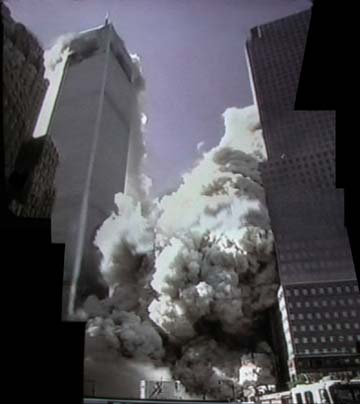
These images were assembled from television coverage which used panning motions to take in wide regions of the scene.
The plume from the collapse of the first tower surged its way between buildings and spilled well into the river. A ground hugging lighter component of the debris cloud lingered behind as great masses of darker smoke billowed skywards.
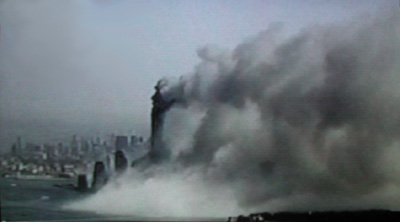
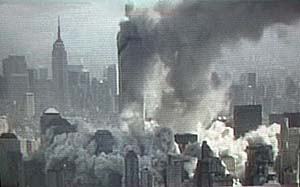
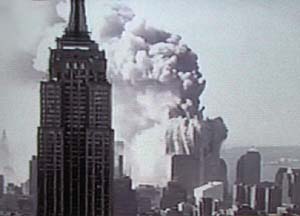 The north
tower shared the fate of its neighbor at 10:29. The weakened structure
crumpled under the load and allowed the fiery top of the building
to drop suddenly, sending bulbous masses of flame in all directions
before gray smoke again formed a gathering avalanche. Again the
gray masses of pulverized structure were blown out then arced
downwards, gathering volume as the building added itself to the
rolling collapse. A thin very tall sliver of one wall persisted
for a few moments, then fell nearly vertically to join the surging
chaos enveloping the region.
The north
tower shared the fate of its neighbor at 10:29. The weakened structure
crumpled under the load and allowed the fiery top of the building
to drop suddenly, sending bulbous masses of flame in all directions
before gray smoke again formed a gathering avalanche. Again the
gray masses of pulverized structure were blown out then arced
downwards, gathering volume as the building added itself to the
rolling collapse. A thin very tall sliver of one wall persisted
for a few moments, then fell nearly vertically to join the surging
chaos enveloping the region.
Many cameras captured the fall of the Twin Towers, among the great tragedies of history. Many police and especially firefighters ran up the stairs to reach those needing help in the upper floors only to lose their lives during the collapse, along with well over a thousand building inhabitants. Suddenly the rectilinear city built of stone, concrete, steel and glass was overwhelmed by a writhing spreading mass of debris surrounded by terrified crowds running for their lives. Some brave camera operators were able to capture their harrowing experiences for posterity.
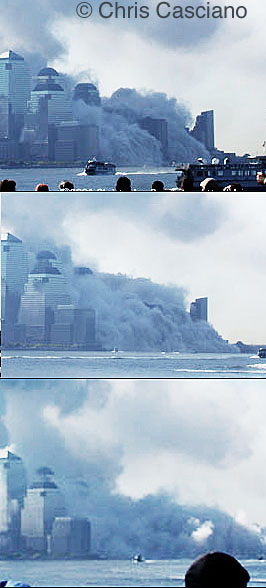
The second plume roared outward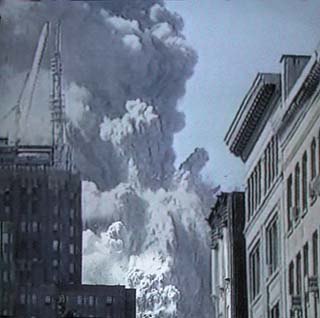 in all directions,
pummeling buildings and people with an abrasive violent debris
laden wind. Close to the collapse the debris cloud caved in windows
and tore chunks from building facades. Powdered concrete, glass,
asbestos, and thousands of pages of paper from destroyed offices
swallowed entire buildings and turbulently enshrouded southern
Manhattan (right).
in all directions,
pummeling buildings and people with an abrasive violent debris
laden wind. Close to the collapse the debris cloud caved in windows
and tore chunks from building facades. Powdered concrete, glass,
asbestos, and thousands of pages of paper from destroyed offices
swallowed entire buildings and turbulently enshrouded southern
Manhattan (right).
At this stage the outer cloud resembled a 'base surge' debris flow from the base of some nuclear explosion clouds, especially the 'Baker' Bikini and 'Plowshare' Sedan tests. One was also reminded of the deadly ground hugging pyroclastic flows from some volcanic eruptions. For a short while it looked as if the entire southern region of the island was consumed (below left).
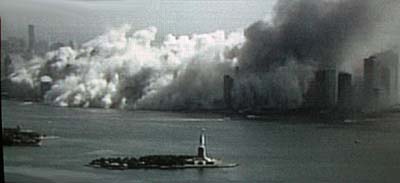
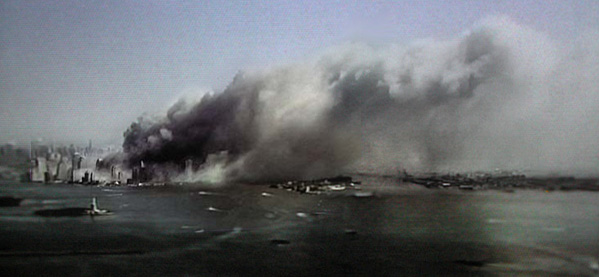
The plume from the collapses mingled with continuing fires to send a great billowing tower of smoke toward the south. The vast plume dwarfed the famous New York skyline and stretched for hundreds of miles out to sea.
From the Space Station the plume erupting from lower Manhattan was easily visible in TV images beamed back down. (left) A wider view was provided by a weather satellite, showing the plume curling and dissipating far downwind.(right)
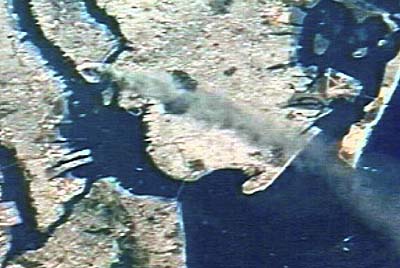
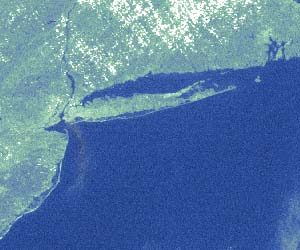
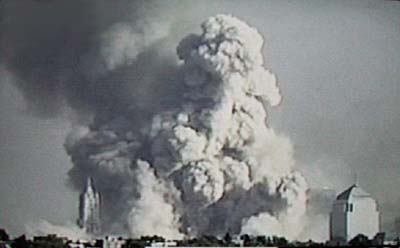
At 5:25 P.M. building seven of the World Trade Center collapsed, sending the third plume of the day into the sky over Manhattan (left). This one towered over the region almost like a nuclear blast cloud might. In a way this devastation could be looked at as a tiny sample, perhaps one per cent, of what lies ahead in a future event when terrorist nuclear weapons are actually used.
The debris clouds left extensive deposits of powdered building debris, ash, and unrecognizable debris over a wide area, and brought respiratory problems to many who breathed it in. (below).

Aside from those in the airliners, about 2,823 people were killed by the destruction of the twin towers, 1,946 of which were at or above the impacted floors. Of that number 343 were firefighters, 78 police and others in uniform. Some 600 died in the south tower, 1,344 in the north tower, at least 50 which jumped to their deaths.